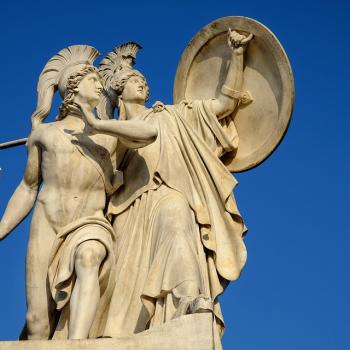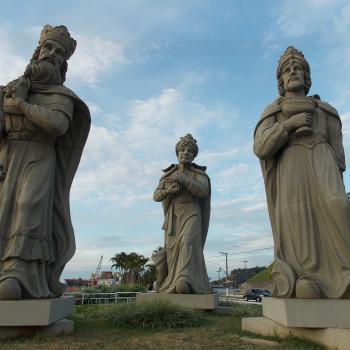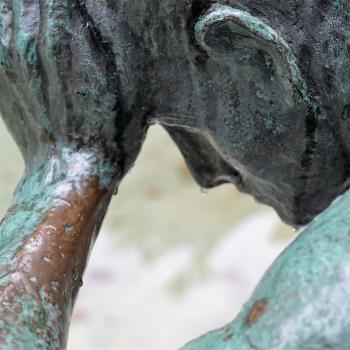This picture is a famous depiction of Christ as Pantocrator, i.e., Christ in Majesty, Ruler of All. It is one of the earliest images of Jesus in the Church. The mystery that the Church proclaimed was that the carpenter’s son- itinerant rabbi-controversial leader-healer-miracle worker-prophetic voice-crucified Roman victim was actually Lord Almighty, the King of Kings and Lord of Lords. Pretty audacious claim.
A few weeks ago I was in Ephesus, and my “interlude” blogpost referred to the Council of Ephesus in 431. There the Church articulated the two-nature identity of Jesus: fully divine, fully human; two natures, not one; yet one person, not two. To settle this, the bishops insisted on using the title theotokos for Mary, the mother of Jesus. Theotokos = Mother of God.
We must realize that this title, used today to honor Mary, was originally intended as a Christological title—it was saying something primarily about Jesus, not about Mary. To say that Mary was theotokos was to say that Mary was the mother of God—insisting that the one person Jesus was God. It’s not like half of Jesus was God, and the other half human, so that Mary got half a son. ALL of Jesus was God. The baby that Mary bore was divine. Through and through divine. AND the baby that Mary bore was her own dear son, her baby boy, her child—ALL human.
So… the question was raised: How did these two natures subsist in the one person, Jesus? How do two natures, two radically differing substances, coexist? And more pertinent to the Trinitarian question: how exactly do we explain the presence of a human being in the context of the divine?
And Gregory’s answer goes to the heart of what the Orthodox church teaches about the nature of salvation. In the person Jesus, “God keeps on actively being God while humanity is divinized” (Anatolios). The divinity of Jesus sanctified the humanity of Jesus.
And when are “in Christ” through faith, we join ourselves to his humanity and become “participants in the divine nature” through his divinity. Instead of God becoming less than God, humans become more than humans. (But never less than human. This description of salvation does not mean that our personality is absorbed or annihilated, or that we become mini-gods or divine substances. We remain human, but just as Christ joins the divine and the human, so we are joined to him, and through him, to God.)
All this, Gregory reminds us, comes from God’s loving kindness, God’s immeasurable goodness, God’s self-giving generosity. God is Good, and all that God does is Good. In baptism, we are invited into “a pattern of exchange in which the recipient embarks on an unceasing participation in the limitless divine goodness” (Anatolios).
If, as the Arians argued, Jesus is something less than God, then he is less than the fullness of all good; if he is less than the fullness of all good, then God has not given himself—he has only given an emissary; if Christ was only an emissary, then he was only doing his job, the thing he was created for—not sacrificing himself in humility. But where does our worship come from? Our thanksgiving? Our adoration? Does it not essentially issue from a wellspring of gratitude, recognizing that the kenosis—the radical humbling that Paul describes in Philippians 2—is a description of God’s own self-giving love?
Thus Gregory pushes us, pushes us hard to shape, as Anatolios describes it, “a doctrine of God that is determined by the Christological narrative.”
This is radically important for the church today. John recognized the danger of “running ahead and not continuing in the teaching of Christ” (2 Jn. 9), and far too many so-called Christians have played leapfrog with Jesus, thinking that they can find God apart from the incarnation-crucifixion-resurrection revelation. Gregory, like Athanasius, gives us “a Christian account of reality that is christologically determined at every point.”
Let me repeat what I said last week: the Trinity is the gospel. The truth about God—Father sending, Son dwelling, Spirit breathing; all Three working in and from one will, one desire, one perfection for the redemption of creation and the communion of God and man—is the good news that the world needs.
Say goodbye to Gregory. He has given us so much to think about. But someone else is knocking at the door… one last voice in this series on Trinitarian life.
Note to Reader: This series on Trinitarian Spirituality explores the history and spirituality behind the shaping of the Nicene Creed using Khaled Anatolios’ Retrieving Nicaea: The Development and Meaning of Trinitarian Doctrine (Grand Rapids, MI: Baker Academic, 2011) as guide and inspiration. It’s best to begin at the beginning: An Introduction.












